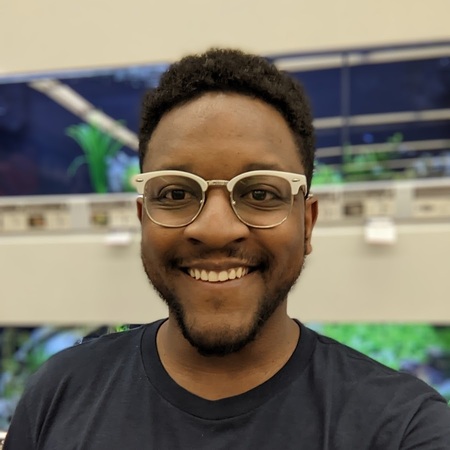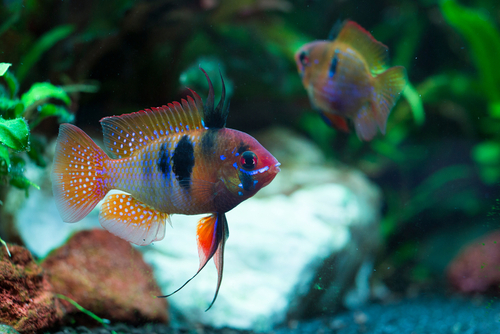If you own a blue ram, you’ll benefit from knowing which fish can and which fish can’t coexist with them. Let’s examine the best blue ram tank mates!
The best blue ram tank mates will be fish that can handle the blue ram’s temperament, such as silver dollar fish or honey gouramis. They will also be able to not just survive, but thrive in similar tank circumstances.
In this article we’ll go over all of the things it takes to make the best blue ram tank mates; we’ll even share our list of the greatest picks. In addition, you will learn what is necessary to know about blue rams as far as their tank parameters, temperament, and more!
Contents
Blue Ram Tank Mates – What You Need to Know
Check out all the information you could possibly need, not just for your blue ram, but also for your tank mates to the blue ram, below!

Temperament
Blue Ram cichlids may may have a bold, colorful appearance, but truthfully, they are pretty peaceful in nature. This is remarkable for the cichlid species, because most cichlids are known to have more aggressive tendencies. The only circumstances in which blue rams can get aggressive are if they are not given enough room in their tank or when they are exhibiting breeding behavior!
Otherwise, as long as you have tank mates that are similarly peaceful, you’ll probably be fine.
Size
In terms of size, you won’t want fish that are much larger than your blue ram. They can mistake the blue ram for a tasty snack swimming by, and you’ll have no end of trouble on your hands. Even if the blue ram is usually peaceful, it is not a good idea to have fish that are significantly smaller than them, either. Go for a similar size!
Competition
The diet of a blue ram is important to understand in order to avoid too much competition between fish at feeding time. Blue rams eat sinking pellets, freeze dried worms, both tubifex and bloodworms, and brine shrimp or mysis shrimp.
The key to minimizing fights over food, even with this peaceful fish, is to cut back on tank mates who eat the exact same things at the exact same time!
Parameters & Tank Setup
Blue rams need tanks that are between 78 and 85 degrees Fahrenheit. They also enjoy plenty of space, with at least 20 gallon tanks being ideal. That said, you’ll also need plenty of plants and even caves to keep all the fish in the same community tank happy and healthy!
Best Blue Ram Tank Mates
Now that you have an idea of how to care for them, we’ll take a closer look at the blue ram’s top contenders for suitable tank mates in the list below.
- Dwarf Gourami
- Silver Dollar Fish
- Betta Fish
- Bristlenose Pleco
- Neon Tetra
- Honey Gourami
- Rummy Nose Tetra
- Bronze Corydoras
- Celestial Pearl Danio
- Clown Loach
You will also like these other top posts in this category:
1. Dwarf Gourami

- Scientific Name: Trichogaster Ialius
- Adult Size: 2 inches
- Compatible With: Blue Ram Cichlids
- Care Level: Medium Difficulty
- Origin: Assam, India, West Bengal, Bangladesh
Dwarf gouramis are some of the most colorful and downright shiny fish available. With one look at their exquisite coloration, it is easy to see why! Dwarf gouramis come in variations such as powder blue gouramis, flame gouramis, and sunset gouramis.
Not only are they beautiful with sloping heads and iridescent colors, but dwarf gouramis are also largely peaceful. They don’t get too big, either, making them fine companions to the blue ram.
Pros of keeping with Blue Ram:
- No aggression
- No food competition
Cons of keeping with Blue Ram :
- None
2. Silver Dollar Fish

- Scientific Name: Metynnis argenteus
- Adult Size: 6 inches
- Compatible With: Blue Ram Cichlids
- Care Level: Easy
- Origin: Brazil, Guyana
Silver Dollar fish might seem like giants in a tank with rams, but they are definitely gentle giants. They will not infringe on the peace-loving blue ram, and they’ll look nice swimming around the middle of the tank.
Silver Dollars are named rather obviously; they are large, round, and flat in shape, much like an actual silver coin. Their silver coloration is very shiny and makes a nice contrast to the highly colorful blue ram.
Pros of keeping with Blue Ram:
- No food competition
- No aggression
Cons of keeping with Blue Ram :
- None
3. Betta Fish

- Scientific Name: Betta splendens
- Adult Size: 3 inches
- Compatible With: Blue Ram Cichlids
- Care Level: Easy
- Origin: Thailand, Cambodia
Called the Siamese Fighting Fish, Betta Fish are known for being scrappy and fighting to the death, but only with other fish of their same species. This is thanks to their territorial disposition.
However, Betta fish make fine tank mates with rams as long as they have plenty of space. They come in a huge variety of colors, and their long fins look like works of art swimming around the tank! Make sure there are plenty of plants and hiding spaces for your betta fish and rams to feel comfortable.
Pros of keeping with Blue Ram:
- No aggression (with non-Bettas)
- No food competition
Cons of keeping with Blue Ram :
- None
4. Bristlenose Pleco

- Scientific Name: Ancistrus cirrhosus
- Adult Size: 5 inches
- Compatible With: Blue Ram Cichlids
- Care Level: Easy
- Origin: Amazon
Bristlenose plecos have been an easy choice for just about every tank because of the mild temperament and ability to eat algae. The Bristlenose pleco is peaceful as it rests on the bottom of the tank, keeps to itself, and cleans up after others.
It is named for it’s slightly bizarre but cute bristly face. It has a flat body with long fins, mainly dark in color but with yellow speckles.
Pros of keeping with Blue Ram:
- No aggression
- No food competition
- Cleans up the tank
Cons of keeping with Blue Ram :
- None
5. Neon Tetra

- Scientific Name: Paracheirodon innesi
- Adult Size: 1 inch
- Compatible With: Blue Ram Cichlids
- Care Level: Easy
- Origin: Peru, Brazil, Colombia
Neon tetras have been described as swimming jewels. This certainly fits their silvery bodies, striped with neon blue and neon red! They are rather small, but with a few of their own kind to swim with, they won’t be intimidated by larger fish.
They are also no threat to the blue ram’s food or space. Enjoy watching neon tetras gallivant around the tank, flashing their shiny bodies!
Pros of keeping with Blue Ram:
- No aggression
- No food competition
Cons of keeping with Blue Ram :
- None
6. Honey Gourami

- Scientific Name: Trichogaster chuna
- Adult Size: 3 inches
- Compatible With: Blue Ram Cichlids
- Care Level:Easy
- Origin: India, Bangladesh
Honey Gouramis are little drops of sunlight in the tank. They may be small, but they are fast and confident with a few of their own kind to swim with. They enjoy dipping in and out of plants and playing hide-and-go-seek, so make sure to keep plenty of foliage in the tank!
The honey gourami is a yellowish color bordering on gold. It usually has gentle brown eyes and transparent fins.
Pros of keeping with Blue Ram:
- No aggression
- No food competition
Cons of keeping with Blue Ram :
- None
7. Rummy Nose Tetra

- Scientific Name: Hemigrammus rhodostomus
- Adult Size: 2 inches
- Compatible With: Blue Ram Cichlids
- Care Level: Moderate Difficulty
- Origin: South America, Amazon
Rummy Nose Tetras are named for their bright red to orange faces, concentrating the color on the snout. They are small, and despite their fiery-looking heads, they are mostly peaceful. This makes them popular choices for aquarium owners wanting to find the perfect match for their fish, and the success is not limited to the blue ram!
Rummy nose tetras are shoaling fish that are silver in color, though in most lights they look nearly transparent because of the reflective quality of their scales. They also have striped tail fins, which are white and black.
Pros of keeping with Blue Ram:
- No aggression
- No food competition
Cons of keeping with Blue Ram :
- None
8. Bronze Corydoras

- Scientific Name: Corydoras aeneus
- Adult Size: 2 inches
- Compatible With: Blue Ram Cichlids
- Care Level: Easy
- Origin: Colombia, Argentina, Venezuela
Corydoras are some of the easiest fish to keep as tank mates, even to the trickiest or most nasty of fish. The bronze corydora is no exception! It is a peaceful fish that dwells at the bottom of the tank and eats a wide variety of foods.
Bronze corys (also known as emerald corys) are named for their bronze or sparkly green coloration. They have catfish-like whiskers and vertical fins. They are not aggressive with blue rams, and clean up the bottom of the tank!
Pros of keeping with Blue Ram:
- No aggression
- No food competition
- Cleans up bottom of the tank
Cons of keeping with Blue Ram :
- None
9. Celestial Pearl Danio

- Scientific Name: Danio Margaritatus
- Adult Size: 1 inch
- Compatible With: Blue Ram Cichlids
- Care Level: Easy
- Origin: Thailand, Myanmar
Celestial pearl danios are also called galaxy rasboras, or even fireworks rasboras. Their fancy names do not disappoint; this fish is absolutely stunning despite it’s small size! They are just about every range of blue on the whole, with speckles of peach to yellow coloring offset by bright orange fins.
Celestial pearl danios live for around 5 years, and during that time they never cause trouble in the tank. They love to school with others, and their small size and mild temperament means no trouble for other peace-lovers like the blue ram.
Pros of keeping with Blue Ram:
- No aggression
- No food competition
Cons of keeping with Blue Ram :
- None
10. Clown Loach

- Scientific Name: Botia macracantha
- Adult Size: 12 inches
- Compatible With: Blue Ram Cichlids
- Care Level: Moderately Difficult
- Origin: Indonesia
The clown loach is one of the other more popular choices for tanks of all types and varieties. These fish can get quite large. However, as they grow, clown loaches remain peaceful and stay on the bottom of the tank, which is a great combination for fish like the blue ram cichlid. Another perk is rams and clown loaches both enjoy warmer than average water temperature. Both will thrive in temps around the mid 80’s.
Clown loaches are named for a slight similarity in the pattern of their colors to clownfish; they are an orangey-yellow with black stripes instead of a clownfish’s white. They have hot orange fins and whiskers to help them detect and eat leftovers on the bottom of the tank!
Pros of keeping with Blue Ram:
- No aggression
- No food competition
- Cleans up bottom of the tank
Cons of keeping with Blue Ram :
- None
In Conclusion
To sum it all up, the best blue ram tank mates are other medium-sized or even small fish species that are peaceful, like the blue ram. They should also be able to survive in warmer water temperatures and eat at different times, the way the silver dollar or dwarf gourami do. With fish like these, your blue ram will have no enemies!

JJ has had a passion for learning about aquatic life since age 5. As an adult, he made his passion a career as a certified aquaculture dealer and aquarium content creator.


